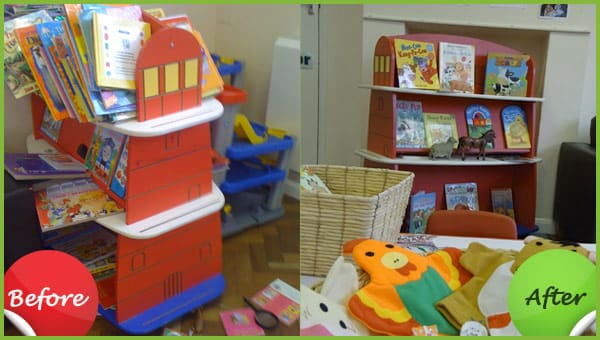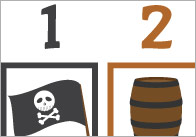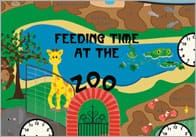Give your book corner a makeover!


How many children spontaneously visit your setting’s or class book area? How long do they stay there, and what do they do? Many settings I visit have a designated space for children to look at books. However children rarely go there, unless they are the most dedicated ‘bookworms’.
As part of my role as Early Language Consultant leading the ECaT project in Thurrock, Essex, I offered a service that became known as ‘Give Your Book Corner a Makeover’ This involved spending time in the space with staff and children, and then together completely changing everything!
Inviting spaces
I work on the principle that ‘less is more’ when it comes to book displays. A huge array of books, often squeezed tightly onto shelves, looks unappealing, damages the books and limits the children’s ability to make an informed choice. We have noticed that as soon as you put a low roof on a space, be it indoors or outdoors, children are drawn to it. So, at Homesteads Pre School, In Stanford-Le Hope, Claire Jarrold and fellow practitioners created their book corner by draping a piece of thin fabric over a strip of elastic . A set of fairy lights draped over the roof was the final touch that really excited the children.
Claire found involving children in creating wall displays for the area was another way of drawing them in. ‘Making a dragon and lanterns for the book corner, as part of our Chinese New Year celebration, created a lot of excitement,’ she says.
Jean Simmonds and colleagues at East Thurrock Kids Club took the drastic step of removing all their large cushions and replacing them with child-sized chairs, a table and a cabinet filled with easily accessible mark-making resources.
Jean says: “It was a bit of a gamble, because the area initially seemed very formal and uninviting, but the children loved it, and immediately wanted to be involved. They could find the books they wanted, and the resources they needed for drawing and mark-making. Gradually we have created interactive displays together, and the more time we spend with the children the longer they stay: sharing books and mark-making. We asked parents to bring in magazines that they enjoyed, reflecting the interests of all the family. Pride of place went to Total Carp, a magazine dedicated to men’s pursuit of massive fish!”
It is important that books reflect the children’s interests. I find that most book areas predominantly contain storybooks. Though these are essential for developing children’s literacy, language and love of books, they can be challenging for some children to understand. Consequently, children often prefer non-fiction books, and particularly those with photos that reflect their interests and knowledge. Choosing books, comics, magazines and even catalogues from local high street stores that appeal to children is a sure-fire way of keeping them involved. In one setting, a display of books and toys relating to children TV programmes and films created a huge amount of interest.
Step by step
At Horndon Village Playgroup, Karen May led her colleagues through a series of steps to revamp their book corner. They started by sorting their book collection into themes. Those that had been loved to death, or were very old or torn, were culled. They involved the children in choosing books about dinosaurs – their current interest – and creating a display, including a dinosaur puppet and other dinosaur toys.
They made sure that they created a balance between storybooks, rhyming books, and non-fiction: a move that immediately attracted more children to the area. They invested in a new sofa, and created an enclosed cushioned space next to the book shelves. They have found that providing a mark-making activity on a nearby table, that relates to the current display of books, again draws in children who would not normally spend time there.
Karen concludes, however: “Really there is only one magic ingredient for encouraging children to engage with books: if an adult is in the area, then children will be there too, so it is vital to plan for adults to spend enough time there for children to be able to share books and chats.”
More information
Michael Jones is an early years trainer and writer. For detailed information about book corner makeovers, including creating inviting spaces for younger children, visit Michael’s website www.talk4meaning.co.uk. There you will find an interactive ‘Book corner makeover audit’ for you and your colleagues to use.
Michael Jones is a freelance trainer in young children’s communication. He led the Every Child a Talker project in three different boroughs. He has written widely on the subject of young children’s language and learning, and is co author of ‘Let’s get talking!’ and ‘Supporting quiet children’, both published by Lawrence Educational. To find out more about Michael’s work visit //www.talk4meaning.co.uk/.
Comments
Leave a Reply
Popular Teaching Resources
Stay Up To Date
Sign up for our newsletter and we’ll let you know when we create new early years resources.






This is great advice, I read your site normally and now I have somewhere else to find more useful information from you!
Thanks Michael, I’ll have to take a look at the book corner in our classroom, it could definitely do with a change
Thanks Jessica
Book areas are one of the best places to explore ideas with children through conversation, so its important that they are inviting and comfortable.
Michael